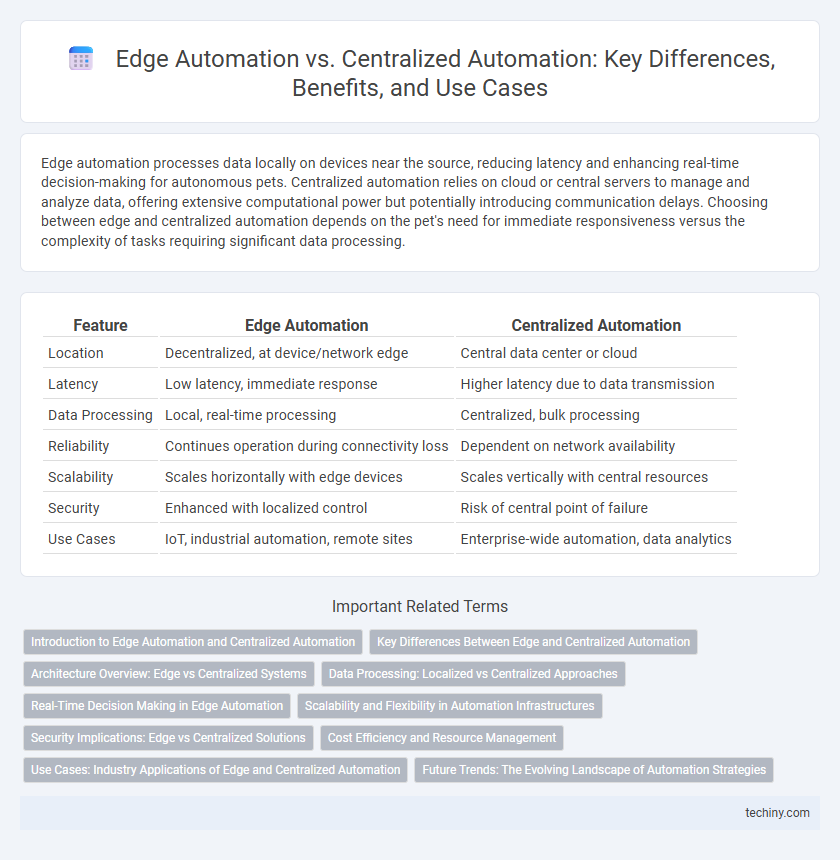Edge automation processes data locally on devices near the source, reducing latency and enhancing real-time decision-making for autonomous pets. Centralized automation relies on cloud or central servers to manage and analyze data, offering extensive computational power but potentially introducing communication delays. Choosing between edge and centralized automation depends on the pet's need for immediate responsiveness versus the complexity of tasks requiring significant data processing.
Table of Comparison
| Feature | Edge Automation | Centralized Automation |
|---|---|---|
| Location | Decentralized, at device/network edge | Central data center or cloud |
| Latency | Low latency, immediate response | Higher latency due to data transmission |
| Data Processing | Local, real-time processing | Centralized, bulk processing |
| Reliability | Continues operation during connectivity loss | Dependent on network availability |
| Scalability | Scales horizontally with edge devices | Scales vertically with central resources |
| Security | Enhanced with localized control | Risk of central point of failure |
| Use Cases | IoT, industrial automation, remote sites | Enterprise-wide automation, data analytics |
Introduction to Edge Automation and Centralized Automation
Edge Automation processes data locally on devices near the source, reducing latency and enhancing real-time decision-making for applications like industrial IoT and autonomous vehicles. Centralized Automation relies on a central server or cloud infrastructure to manage workflows and data analysis, enabling large-scale coordination and simplified maintenance. Both methods optimize operational efficiency, but Edge Automation excels in speed and responsiveness, while Centralized Automation provides comprehensive control and integration.
Key Differences Between Edge and Centralized Automation
Edge automation processes data locally on devices or edge servers, reducing latency and improving real-time decision-making capabilities. Centralized automation relies on a centralized data center or cloud infrastructure, which enables comprehensive data analysis but often encounters higher latency and bandwidth dependency. Key differences include data processing location, latency impact, and network dependency, with edge automation favoring speed and local control, while centralized automation emphasizes scalability and centralized management.
Architecture Overview: Edge vs Centralized Systems
Edge automation architecture distributes processing power and decision-making closer to data sources, reducing latency and enabling real-time analytics, while centralized automation relies on a core data center or cloud infrastructure for processing and control. Edge systems feature decentralized nodes equipped with local computing resources, which enhances scalability and fault tolerance compared to centralized systems that depend on a single point of orchestration. Centralized architectures facilitate unified data management and simplified updates but may suffer from bandwidth limitations and delayed responses due to data transmission times.
Data Processing: Localized vs Centralized Approaches
Edge automation processes data locally on devices or edge servers, reducing latency and improving real-time decision-making for critical applications. Centralized automation relies on cloud or data center infrastructure to aggregate and analyze data, benefiting from greater computational power and advanced analytics. Localized data processing enhances security by minimizing data transmission, whereas centralized approaches enable comprehensive insights through large-scale data integration.
Real-Time Decision Making in Edge Automation
Edge automation enhances real-time decision making by processing data locally on devices or edge servers, reducing latency and enabling instantaneous responses critical for applications like autonomous vehicles and industrial IoT. Unlike centralized automation, which relies on data transmission to a distant cloud, edge automation minimizes bandwidth usage and mitigates risks associated with network delays or outages. This immediacy supports adaptive control and predictive maintenance, driving efficiency and operational resilience in dynamic environments.
Scalability and Flexibility in Automation Infrastructures
Edge automation enables greater scalability by distributing processing power closer to data sources, reducing latency and bandwidth usage. Centralized automation offers streamlined control but can become a bottleneck as infrastructure scales, limiting flexibility in adapting to diverse operational environments. Combining edge and centralized automation optimizes scalability and flexibility, supporting dynamic workloads and diverse industrial applications.
Security Implications: Edge vs Centralized Solutions
Edge automation enhances security by processing data locally, reducing the attack surface and minimizing latency-related vulnerabilities common in centralized systems. Centralized automation centralizes sensitive data, increasing risks of large-scale breaches and making systems more attractive targets for cyberattacks. Implementing robust encryption and access controls is crucial in both models, though edge solutions inherently limit exposure through decentralized architecture.
Cost Efficiency and Resource Management
Edge automation reduces latency and bandwidth costs by processing data locally on devices, optimizing resource management through decentralized control. Centralized automation requires significant investment in robust network infrastructure and cloud resources, leading to higher operational costs but enabling easier oversight and uniform policy enforcement. Cost efficiency in edge systems excels in scenarios with distributed assets or intermittent connectivity, while centralized systems favor large-scale, data-intensive environments needing consolidated analytics.
Use Cases: Industry Applications of Edge and Centralized Automation
Edge automation is pivotal in industries requiring real-time data processing and immediate responses, such as manufacturing, autonomous vehicles, and healthcare, where latency reduction and local decision-making enhance operational efficiency and safety. Centralized automation excels in large-scale data coordination and complex analytics, supporting sectors like energy management, supply chain logistics, and smart cities by enabling comprehensive oversight and optimization. Both approaches integrate seamlessly in hybrid models, leveraging edge's responsiveness and centralized systems' computational power to drive innovation across diverse industrial applications.
Future Trends: The Evolving Landscape of Automation Strategies
Edge automation leverages decentralized processing power close to data sources, enhancing real-time decision-making and reducing latency in IoT environments. Centralized automation continues to excel in managing large-scale enterprise workflows through robust cloud infrastructure and consolidated data analysis. Emerging trends indicate a hybrid approach integrating edge and centralized systems to optimize scalability, security, and operational efficiency in future automation strategies.
Edge Automation vs Centralized Automation Infographic

 techiny.com
techiny.com